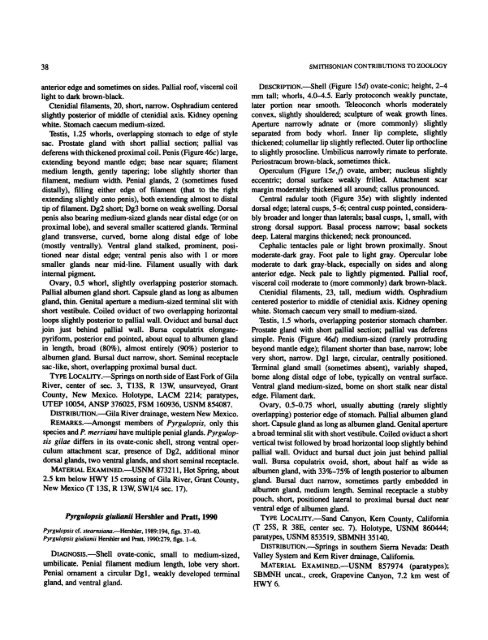A Review of the North American Freshwater Snail Genus Pyrgulopsis
A Review of the North American Freshwater Snail Genus Pyrgulopsis
A Review of the North American Freshwater Snail Genus Pyrgulopsis
You also want an ePaper? Increase the reach of your titles
YUMPU automatically turns print PDFs into web optimized ePapers that Google loves.
38<br />
anterior edge and sometimes on sides. Pallial ro<strong>of</strong>, visceral coil<br />
light to dark brown-black.<br />
Ctenidial filaments, 20, short, narrow. Osphradium centered<br />
slightly posterior <strong>of</strong> middle <strong>of</strong> ctenidial axis. Kidney opening<br />
white. Stomach caecum medium-sized.<br />
Testis, 1.2S whorls, overlapping stomach to edge <strong>of</strong> style<br />
sac. Prostate gland with short pallial section; pallial vas<br />
deferens with thickened proximal coil. Penis (Figure 46c) large,<br />
extending beyond mantle edge; base near square; filament<br />
medium length, gently tapering; lobe slightly shorter than<br />
filament, medium width. Penial glands, 2 (sometimes fused<br />
distally), filling ei<strong>the</strong>r edge <strong>of</strong> filament (that to <strong>the</strong> right<br />
extending slightly onto penis), both extending almost to distal<br />
tip <strong>of</strong> filament Dg2 short; Dg3 borne on weak swelling. Dorsal<br />
penis also bearing medium-sized glands near distal edge (or on<br />
proximal lobe), and several smaller scattered glands. Terminal<br />
gland transverse, curved, borne along distal edge <strong>of</strong> lobe<br />
(mostly ventrally). Ventral gland stalked, prominent, positioned<br />
near distal edge; ventral penis also with 1 or more<br />
smaller glands near mid-line. Filament usually with dark<br />
internal pigment.<br />
Ovary, 0.5 whorl, slightly overlapping posterior stomach.<br />
Pallial albumen gland short Capsule gland as long as albumen<br />
gland, thin. Genital aperture a medium-sized terminal slit with<br />
short vestibule. Coiled oviduct <strong>of</strong> two overlapping horizontal<br />
loops slightly posterior to pallial wall. Oviduct and bursal duct<br />
join just behind pallial wall. Bursa copulatrix elongatepyriform,<br />
posterior end pointed, about equal to albumen gland<br />
in length, broad (80%), almost entirely (90%) posterior to<br />
albumen gland. Bursal duct narrow, short. Seminal receptacle<br />
sac-like, short, overlapping proximal bursal duct.<br />
TYPE LOCALITY.—Springs on north side <strong>of</strong> East Fork <strong>of</strong> Gila<br />
River, center <strong>of</strong> sec. 3, T13S, R 13W, unsurveyed, Grant<br />
County, New Mexico. Holotype, LACM 2214; paratypes,<br />
UTEP 10054, ANSP 376025, FSM 160936, USNM 854087.<br />
DISTRIBUTION.—Gila River drainage, western New Mexico.<br />
REMARKS.—Amongst members <strong>of</strong> <strong>Pyrgulopsis</strong>, only this<br />
species and P. merriami have multiple penial glands. <strong>Pyrgulopsis</strong><br />
gilae differs in its ovate-conic shell, strong ventral operculum<br />
attachment scar, presence <strong>of</strong> Dg2, additional minor<br />
dorsal glands, two ventral glands, and short seminal receptacle.<br />
MATERIAL EXAMINED.—USNM 873211, Hot Spring, about<br />
2.5 km below HWY 15 crossing <strong>of</strong> Gila River, Grant County,<br />
New Mexico (T 13S, R 13W, SW1/4 sec. 17).<br />
<strong>Pyrgulopsis</strong> giulianii Hershler and Pratt, 1990<br />
<strong>Pyrgulopsis</strong> cf. stearnsiana.—Hershler, 1989:194, figs. 37-40.<br />
<strong>Pyrgulopsis</strong> giulianii Hershler and Pratt, 1990:279, figs. 1-4.<br />
DIAGNOSIS.—Shell ovate-conic, small to medium-sized,<br />
umbilicate. Penial filament medium length, lobe very short.<br />
Penial ornament a circular Dgl, weakly developed terminal<br />
gland, and ventral gland.<br />
SMITHSONIAN CONTRIBUTIONS TO ZOOLOGY<br />
DESCRIPTION.—Shell (Figure I5d) ovate-conic; height, 2-4<br />
mm tall; whorls, 4.0-4.5. Early protoconch weakly punctate,<br />
later portion near smooth. Teleoconch whorls moderately<br />
convex, slightly shouldered; sculpture <strong>of</strong> weak growth lines.<br />
Aperture narrowly adnate or (more commonly) slightly<br />
separated from body whorl. Inner lip complete, slightly<br />
thickened; columellar lip slightly reflected. Outer lip orthocline<br />
to slightly prosocline. Umbilicus narrowly rimate to perforate.<br />
Periostracum brown-black, sometimes thick.<br />
Operculum (Figure \5e,f) ovate, amber, nucleus slightly<br />
eccentric; dorsal surface weakly frilled. Attachment scar<br />
margin moderately thickened all around; callus pronounced.<br />
Central radular tooth (Figure 35e) with slightly indented<br />
dorsal edge; lateral cusps, 5-6; central cusp pointed, considerably<br />
broader and longer than laterals; basal cusps, 1, small, with<br />
strong dorsal support Basal process narrow; basal sockets<br />
deep. Lateral margins thickened; neck pronounced.<br />
Cephalic tentacles pale or light brown proximally. Snout<br />
moderate-dark gray. Foot pale to light gray. Opercular lobe<br />
moderate to dark gray-black, especially on sides and along<br />
anterior edge. Neck pale to lightly pigmented. Pallial ro<strong>of</strong>,<br />
visceral coil moderate to (more commonly) dark brown-black.<br />
Ctenidial filaments, 23, tall, medium width. Osphradium<br />
centered posterior to middle <strong>of</strong> ctenidial axis. Kidney opening<br />
white. Stomach caecum very small to medium-sized.<br />
Testis, 1.5 whorls, overlapping posterior stomach chamber.<br />
Prostate gland with short pallial section; pallial vas deferens<br />
simple. Penis (Figure 46d) medium-sized (rarely protruding<br />
beyond mantle edge); filament shorter than base, narrow; lobe<br />
very short, narrow. Dgl large, circular, centrally positioned.<br />
Terminal gland small (sometimes absent), variably shaped,<br />
borne along distal edge <strong>of</strong> lobe, typically on ventral surface.<br />
Ventral gland medium-sized, borne on short stalk near distal<br />
edge. Filament dark.<br />
Ovary, 0.5-0.75 whorl, usually abutting (rarely slightly<br />
overlapping) posterior edge <strong>of</strong> stomach. Pallial albumen gland<br />
short. Capsule gland as long as albumen gland. Genital aperture<br />
a broad terminal slit with short vestibule. Coiled oviduct a short<br />
vertical twist followed by broad horizontal loop slightly behind<br />
pallial wall. Oviduct and bursal duct join just behind pallial<br />
wall. Bursa copulatrix ovoid, short, about half as wide as<br />
albumen gland, with 33%-75% <strong>of</strong> length posterior to albumen<br />
gland. Bursal duct narrow, sometimes partly embedded in<br />
albumen gland, medium length. Seminal receptacle a stubby<br />
pouch, short, positioned lateral to proximal bursal duct near<br />
ventral edge <strong>of</strong> albumen gland.<br />
TYPE LOCALITY.—Sand Canyon, Kern County, California<br />
(T 25S, R 38E, center sec. 7). Holotype, USNM 860444;<br />
paratypes, USNM 853519, SBMNH 35140.<br />
DISTRIBUTION.—Springs in sou<strong>the</strong>rn Sierra Nevada: Death<br />
Valley System and Kern River drainage, California.<br />
MATERIAL EXAMINED.—USNM 857974 (paratypes);<br />
SBMNH uncat, creek, Grapevine Canyon, 7.2 km west <strong>of</strong><br />
HWY 6.

















